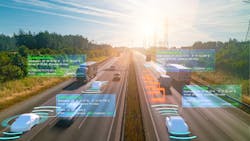Blending Machine Learning and Radar for Enhanced Navigation
What you’ll learn:
- What’s enabled by central processing architecture?
- The advantage of having radar and camera versus one or the other.
- What is the problem is with LiDAR?
Two hot technologies these days are artificial intelligence (AI) and self-driving cars. One of the sensors used with the latter is radar. Oculii is a company that’s merging machine learning and radar to deliver a more effective solution to automotive navigation and obstacle avoidance.
I talked with Steven Hong, CEO/Co-Founder of Oculii, about their software platform.
What is it that your company does?
Oculii is creating a next-generation AI software platform for radars that’s significantly higher resolution, longer range, more accurate, and less expensive than conventional solutions—increasing safety and reliability. The promise of autonomous vehicles depends on high-performance, all-weather, low-cost, and scalable perception technology, and Oculii is bringing it to the world.
What’s one problem that your company is working to solve?
There are 6 million car accidents in the U.S. every year, many of which are fatal. Additionally, 96% of those accidents are caused partially by human error. The biggest problem we’re working to solve is to make safe transportation more accessible.
Current radar solutions fall short of the industry’s autonomy needs. Before Oculii, enabling higher levels of autonomy required more cameras, increasing cost, size, and power consumption. Oculii’s software unlocks the potential of low-cost, mass-manufacturable, market-proven commercial radars, making autonomy more accessible to all.
Tell us about the acquisition with Ambarella. What does this mean for your company?
Joining the Ambarella team has allowed us to expand the development of our radar technology and utilize Ambarella’s camera technology to create higher levels of autonomy for automotive Tier 1s and OEMs globally. Oculli’s radar technology expands Ambarella’s existing edge AI CV [computer vision] perception SoCs for automotive and other IoT endpoint applications, including mobile robotics and security.
What's the advantage of having radar and camera versus one or the other?
The camera provides RBG information and is great at object detection, classification, and sign recognition, but it has drastically reduced performance in inclement weather. Radar is a natural complement to cameras as it provides accurate range and Doppler data while being unaffected by weather conditions. These sensing modalities naturally complement each other, and, unlike LiDAR, are cost-effective enough to be deployed on L2+ vehicles.
With one or the other, more resolution could mean more power, processing, and cost. However, the combination of radar, camera, and Oculii’s software unlocks higher resolution without sacrificing efficiency.
What does a central processing architecture enable?
With the addition of centralized processing, Oculii software can increase the resolution up to 1,000X compared to traditional radar.
Most systems currently process on decades-old technology. Oculii's central fusion platform allows radar data to inform camera data and vice versa for the fastest and smartest autonomous systems possible.
Compute resources in the central processing architecture scale more cost-effectively as this is housed in a single SoC. In addition, there will be reduced insurance rates for consumers since the radar sensor replacement cost will be lower in the case of an accident. Lastly, there will be a simpler software solution—only one device needs an over-the-air update rather than multiple radar modules.
What technology trends are you most excited about?
Radar’s potential as an autonomous navigation technology is not as widely recognized as it should be. LiDAR is the more well-known navigation system and it gets a lot of media attention due to the high number of LiDAR-focused startups.
While there are many great LiDAR companies doing interesting work, radar is often seen as an already solved problem. Traditionally, improving radar resolution meant adding more antennae, which increased cost, size, and power. But that was before Oculii. With Oculii’s virtual aperture imaging technology, we’ve found a software solution to a hardware problem, which has unlocked outstanding potential for radar.
Radar is very cost-effective, which could be a key component in getting self-driving technology more broadly adopted. It is also extremely robust and can perform in all weather conditions.
Oculii’s software enables all of the benefits of the radar, as well as the high resolution and long-range performance. Oculii’s Virtual Aperture Imaging software platform also evolves constantly by leveraging unique and proprietary radar data models. Future generations of sensors built with Oculii AI software will scale exponentially, delivering significantly higher resolution and longer range in a cheaper and more compact package.
Steven Hong is CEO/Co-Founder of Oculii, a radar software company enabling the next generation of autonomous systems. Using aperture imaging software that dynamically learns and adapts to the environment, Oculii’s proprietary virtual aperture imaging software increases the resolution of any radar hardware by up to 100X.
About the Author
William G. Wong
Senior Content Director - Electronic Design and Microwaves & RF
I am Editor of Electronic Design focusing on embedded, software, and systems. As Senior Content Director, I also manage Microwaves & RF and I work with a great team of editors to provide engineers, programmers, developers and technical managers with interesting and useful articles and videos on a regular basis. Check out our free newsletters to see the latest content.
You can send press releases for new products for possible coverage on the website. I am also interested in receiving contributed articles for publishing on our website. Use our template and send to me along with a signed release form.
Check out my blog, AltEmbedded on Electronic Design, as well as his latest articles on this site that are listed below.
You can visit my social media via these links:
- AltEmbedded on Electronic Design
- Bill Wong on Facebook
- @AltEmbedded on Twitter
- Bill Wong on LinkedIn
I earned a Bachelor of Electrical Engineering at the Georgia Institute of Technology and a Masters in Computer Science from Rutgers University. I still do a bit of programming using everything from C and C++ to Rust and Ada/SPARK. I do a bit of PHP programming for Drupal websites. I have posted a few Drupal modules.
I still get a hand on software and electronic hardware. Some of this can be found on our Kit Close-Up video series. You can also see me on many of our TechXchange Talk videos. I am interested in a range of projects from robotics to artificial intelligence.


